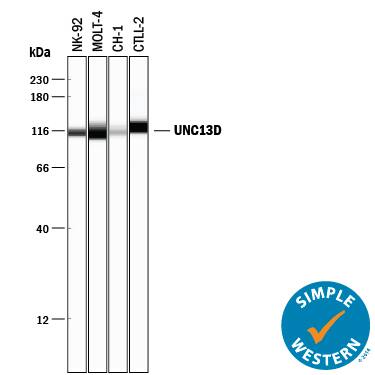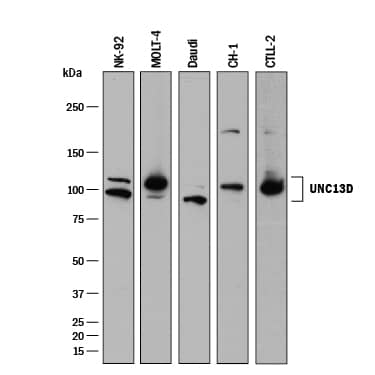Human/Mouse UNC13D Antibody
R&D Systems, part of Bio-Techne | Catalog # MAB89662
Recombinant Monoclonal Antibody.

Key Product Details
Species Reactivity
Human, Mouse
Applications
Simple Western, Western Blot
Label
Unconjugated
Antibody Source
Recombinant Monoclonal Rabbit IgG Clone # 1224B
Product Specifications
Immunogen
KLH-coupled N-terminal human UNC13D peptide
Accession # Q70J99
Accession # Q70J99
Specificity
Detects human and mouse UNC13D in Western blots.
Clonality
Monoclonal
Host
Rabbit
Isotype
IgG
Scientific Data Images for Human/Mouse UNC13D Antibody
Detection of Human and Mouse UNC13D by Western Blot.
Western blot shows lysates of NK-92 human natural killer lymphoma cell line, MOLT-4 human acute lymphoblastic leukemia cell line, Daudi human Burkitt's lymphoma cell line, CH-1 mouse B cell lymphoma cell line, and CTLL-2 mouse cytotoxic T cell line. PVDF membrane was probed with 0.5 µg/mL of Rabbit Anti-Human/Mouse UNC13D Monoclonal Antibody (Catalog # MAB89662) followed by HRP-conjugated Anti-Rabbit IgG Secondary Antibody (Catalog # HAF008). Specific bands were detected for UNC13D at approximately 95-115 kDa (as indicated). This experiment was conducted under reducing conditions and using Immunoblot Buffer Group 1.Detection of Human and Mouse UNC13D by Simple WesternTM.
Simple Western lane view shows lysates of NK‑92 human natural killer lymphoma cell line, MOLT‑4 human acute lymphoblastic leukemia cell line, CH‑1 mouse B cell lymphoma cell line, and CTLL‑2 mouse cytotoxic T cell line, loaded at 0.2 mg/mL. A specific band was detected for UNC13D at approximately 112-122 kDa (as indicated) using 5 µg/mL of Rabbit Anti-Human/Mouse UNC13D Monoclonal Antibody (Catalog # MAB89662) . This experiment was conducted under reducing conditions and using the 12-230 kDa separation system.Applications for Human/Mouse UNC13D Antibody
Application
Recommended Usage
Simple Western
5 µg/mL
Sample: NK‑92 human natural killer lymphoma cell line, MOLT‑4 human acute lymphoblastic leukemia cell line, CH‑1 mouse B cell lymphoma cell line, and CTLL‑2 mouse cytotoxic T cell line
Sample: NK‑92 human natural killer lymphoma cell line, MOLT‑4 human acute lymphoblastic leukemia cell line, CH‑1 mouse B cell lymphoma cell line, and CTLL‑2 mouse cytotoxic T cell line
Western Blot
0.5 µg/mL
Sample: NK‑92 human natural killer lymphoma cell line, MOLT‑4 human acute lymphoblastic leukemia cell line, Daudi human Burkitt's lymphoma cell line, CH‑1 mouse B cell lymphoma cell line, and CTLL‑2 mouse cytotoxic T cell line
Sample: NK‑92 human natural killer lymphoma cell line, MOLT‑4 human acute lymphoblastic leukemia cell line, Daudi human Burkitt's lymphoma cell line, CH‑1 mouse B cell lymphoma cell line, and CTLL‑2 mouse cytotoxic T cell line
Formulation, Preparation, and Storage
Purification
Protein A or G purified from cell culture supernatant
Reconstitution
Reconstitute at 0.5 mg/mL in sterile PBS. For liquid material, refer to CoA for concentration.
Formulation
Lyophilized from a 0.2 μm filtered solution in PBS with Trehalose. *Small pack size (SP) is supplied either lyophilized or as a 0.2 µm filtered solution in PBS.
Shipping
Lyophilized product is shipped at ambient temperature. Liquid small pack size (-SP) is shipped with polar packs. Upon receipt, store immediately at the temperature recommended below.
Stability & Storage
Use a manual defrost freezer and avoid repeated freeze-thaw cycles.
- 12 months from date of receipt, -20 to -70 °C as supplied.
- 1 month, 2 to 8 °C under sterile conditions after reconstitution.
- 6 months, -20 to -70 °C under sterile conditions after reconstitution.
Background: UNC13D
Long Name
UNC-13 Homolog D
Alternate Names
FHL3, HLH3, HPLH3, Munc13-4
Gene Symbol
UNC13D
UniProt
Additional UNC13D Products
Product Documents for Human/Mouse UNC13D Antibody
Product Specific Notices for Human/Mouse UNC13D Antibody
For research use only
